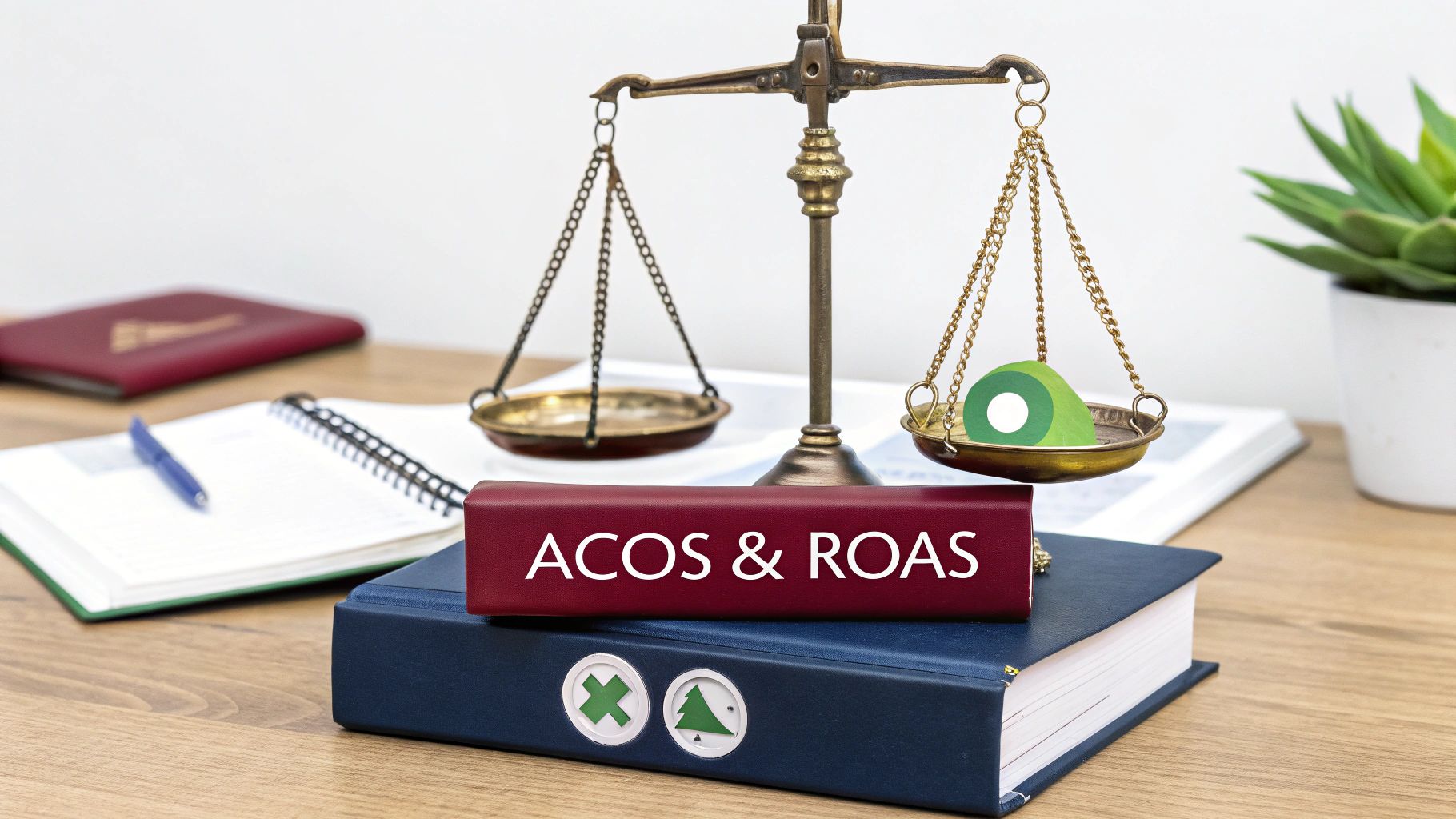When you’re running Amazon PPC campaigns, you’ll see ACoS and ROAS everywhere. ACoS (Advertising Cost of Sale) tells you how much of your revenue gets eaten up by ad spend. On the other hand, ROAS (Return on Ad Spend) shows how much revenue you generate for every dollar you spend on ads, highlighting your return.
ACoS vs ROAS: A Quick Comparison
Think of ACoS and ROAS as two different ways of looking at the same performance data. ACoS asks, “What percentage of my ad sales went back into ad spend?” while ROAS asks, “For every $1 I put into ads, how many dollars did I get back?”
Focusing only on one metric can be seriously misleading. A super low ACoS might feel like a win, but it could also mean you’re being too conservative and leaving a ton of potential sales on the table.
Let’s say you spend $500 on an ad campaign and it brings in $2,000 in sales.
- Your ACoS is 25% ($500 ad spend / $2,000 ad sales).
- Your ROAS is 4.0 ($2,000 ad sales / $500 ad spend).
See? Same data, different metrics. Both are necessary for figuring out how to use your budget effectively. If you’re new to the advertising side of Amazon, our guide on what is PPC on Amazon can get you up to speed.
To see how these Amazon-specific metrics fit into the bigger picture, it’s helpful to compare them with broader strategies for measuring marketing effectiveness used across other channels.
How to Calculate and Use Your Breakeven ACoS
Before you can make ACoS work for you, you need to find your breakeven ACoS. It marks the point where your ad spend perfectly cancels out your profit on a sale. You’re not making money, but you’re not losing it, either.
Simply put, your breakeven ACoS is your profit margin before you factor in ad spend.
Calculating Your Breakeven ACoS
Let’s walk through a quick example. Say you’re selling a product for $50. After COGS, Amazon fees, and everything else, your profit is $20 per unit. This is your pre-advertising profit.
- Profit Margin: ($20 Profit / $50 Sale Price) = 40%
- Breakeven ACoS: 40%
That’s it. 40% is your line in the sand. Any ACoS below that number means you’re pocketing a profit on that ad sale. Anything above it, and you’re at loss.
Getting this number right means you need a solid understanding of all your costs. If you’re unsure about the details, our guide on Amazon fees for sellers is a good place to start.

Setting Your Target ACoS
Here’s a key distinction: your breakeven ACoS is your limit, not your goal. Your actual target ACoS should be a strategic choice that shifts with your business objectives.
- Product Launch: You might be perfectly happy with a target ACoS that’s higher than your breakeven, say, 70%. The goal isn’t profit at the launch stage. At launch stage you spend heavy to get data, generate initial sales, and kickstarting the Amazon flywheel with reviews and organic rank.
- Profitability: For a mature, established product, you’ll want to flip the script. A much lower target, like 20%-30%, lets you squeeze as much profit as possible from every ad-driven sale.
Finally, once you’ve got a handle on ACoS, you can start looking at a more advanced metric: TACoS (Total Advertising Cost of Sale). TACoS measures your ad spend against your total sales (both organic and ad-driven). This gives you the bigger picture, showing how your ad spend is lifting sales across your entire business, not just the ones you can directly attribute to a click.
Using ROAS to Measure Your Growth Potential
While ACoS is great for managing the day-to-day profitability of your campaigns, ROAS (Return on Ad Spend) gives you that high-level, big-picture view of your growth engine. If ACoS tells you how much a sale costs you in ads, ROAS tells you how much revenue each ad dollar earns you.
ROAS is the universal language of digital marketing, used across platforms like Google and Facebook. This makes it a useful KPI for comparing the performance of your Amazon ads against other marketing channels. A 4x ROAS on Amazon means you’re generating $4 in revenue for every $1 spent.

What Is a Good ROAS on Amazon?
There’s no universal “good” ROAS. What’s good for one brand might be unprofitable for another, it all depends on your margins, goals, and category.
A brand with a strong 70% profit margin might be happy with a 2.5x ROAS since they’re still earning solid profit per unit sold even after spending heavy on ads.
On the other hand, a seller with a slim 15% margin may need a 5x ROAS or higher just to profitable after ads, fees, and other costs.
While ACoS is the primary metric in the Amazon ecosystem, other major platforms use ROAS. A Google Ads campaign that brings in $100 in sales from $25 in spend has a 4x ROAS, a beautifully straightforward measure of return.
Understanding ROAS helps you decide where to allocate your budget for maximum impact, a key part of our strategies on how to improve Amazon sales. To push your growth even further, you can explore strategies like maximizing return on investment (ROI) through retargeting, which directly improves your overall ROAS.
When to Put ACoS First in Your Campaigns
While ROAS is great for a bird’s-eye view of revenue, ACoS is your boots-on-the-ground metric for managing campaigns and protecting your profits. It’s the number that tells you if your ad spend is working on a product-by-product basis. So, when does ACoS take the driver’s seat?
ACoS becomes the star of the show when controlling costs is a bigger deal than chasing aggressive, top-line growth.
Protecting Thin Profit Margins
If you’re selling in a crowded category or your products don’t have much room on margin, ACoS is everything. For a product with only a 20% profit margin before advertising, every ad dollar has to pull its weight.
In this scenario, your breakeven ACoS is 20%. Your goal is to keep your target ACoS well below that number to make sure every ad-driven sale actually puts money in your pocket.
When your margins are thin, a sky-high ROAS means nothing if ACoS is eating up all your profit. ACoS is the guardrail that keeps you from paying Amazon.
Managing Established Products
Have a product that’s been selling well for a while? One with a solid sales history and a comfortable organic ranking? The game changes. You’re no longer scrambling to capture the market; you’re focused on generating consistent, profitable sales.
Here, you’ll want to set and stick to a low target ACoS, perhaps somewhere in the 15-25% range. This keeps your ad spend efficient and protects your bottom line while still grabbing extra sales from PPC. A tighter ACoS range also makes performance shifts easier to spot. For instance, if your click-through rate suddenly drops, it could signal a listing or targeting issue. If that happens, check out our guide to improve Amazon CTR.
Operating on a Fixed Ad Budget
Many sellers, especially smaller brands or those just starting out, work with a set ad budget each month. When your funds are finite, you can’t afford to waste a single cent on clicks that go nowhere.
Focusing on ACoS is how you squeeze the most out of every dollar. By constantly working to lower your ACoS, you’re making your ad spend more efficient. This lets your fixed budget stretch further, ultimately generating more sales than it would if you were just chasing revenue.
When a ROAS-First Strategy Makes More Sense
While ACoS is your go-to metric for protecting profits, ROAS (Return on Ad Spend) is all about measuring momentum and fueling growth. Think of a ROAS-first mindset as being less about immediate cost-efficiency and more about the long-term strategic value of every dollar you put into advertising. It’s the right call in a few key situations.
You’ll want to lean on ROAS when your main objective is to scale your revenue aggressively. This is common for brands with healthy cash flow who are ready to reinvest heavily into their ads to capture more market share.
Launching a New Product
When you’re launching a new product, your goal isn’t profit; it’s sales velocity. You need to get your product seen, clicked, and bought to kickstart Amazon’s ranking algorithm. A ROAS-first approach lets you focus on generating maximum revenue from your ad spend, even if it means running at a high ACoS for a while.
This aggressive spending helps you quickly gather data, identify winning keywords, and build the sales history needed to start climbing the organic ranks.
Selling High-Margin Products
If you sell premium products with fat profit margins, you have more room to play. Let’s say your brand sells a skincare line with a 70% gross margin. A 50% ACoS would look terrifying to a low-margin seller, but for you, it’s still very profitable.
In this case, a 2x ROAS (which is the same as a 50% ACoS) is perfectly acceptable. You’re generating $2 for every $1 spent and still banking a healthy profit on each sale. This flexibility allows you to outbid competitors and dominate valuable keywords.
Recent data from ad analytics firms suggests that a “good” ROAS often exceeds 3.0, but this is highly dependent on your margins and business goals. Brands selling at scale often choose ROAS to maximize revenue returns, especially if they have higher margins to work with. You can discover more insights about this on SarasAnalytics.com.
Finding the Right Balance Between ACoS and ROAS
Many sellers get stuck focusing on one metric and ignoring the other. The truth is, both ACoS and ROAS tell different sides of the same story.
- ACoS shows how much of your sales go toward ads.
- ROAS shows how much revenue you earn for every dollar spent.
When used together, they reveal whether your ad spend is truly profitable or just looks good on paper.
For example, if your campaign has an 6x ROAS but your ACoS is 45% and your product margin is 15%, you’re actually losing money. The combination of both metrics helps you catch situations like this quickly.

A Practical Framework for Goal Setting
Every strong ad strategy needs two clear limits.
1. Maximum ACoS Target
This is the highest ACoS your campaign can reach before it stops being profitable. To calculate it, start with your product margin.
If your margin is 40%, your breakeven ACoS is 40%. Anything higher means you’re losing money. A good rule is to keep your target ACoS slightly lower, around 30–35%, to leave room for fees, refunds, or discounts.
You sell a $50 product with a 40% profit margin, giving you $20 profit before ads. If your campaign ACoS is 30%, you spend $15 on ads and keep $5 profit. If your ACoS hits 45%, you spend $22.50 and lose $2.50 per sale.
2. Minimum ROAS Target
ROAS is the reverse of ACoS. It tells you how much you earn for each dollar spent.
- If your breakeven ACoS is 40%, your minimum ROAS should be around 2.5x.
- If your breakeven ACoS is 25%, your minimum ROAS should be around 4x.
In simple terms, if your product can handle 40% ad spend, your campaign needs at least 2.5x ROAS to stay profitable.
To set a realistic minimum ROAS target:
- Start from your breakeven ACoS based on your actual margins.
- Add a 10–15% buffer for ad fees, coupons, or seasonal dips.
- Check performance weekly and pause any campaign that stays below your target for too long.
You don’t have to pick between ACoS and ROAS. The goal is to make them work together.
ACoS keeps your spending efficient, and ROAS ensures that your investment delivers real return.
When both are aligned with your actual profit margins, your campaigns move from guesswork to data-driven decisions. That’s how you build ad strategies that grow sales while keeping profits intact.
Common Questions About ACoS and ROAS
Once you get the hang of the basics, you’ll still bump into specific situations where ACoS and ROAS can be tricky. Here are some of the most common questions I hear from sellers just like you.
What Is a Good ACoS on Amazon?
Honestly, there’s no magic number here. A “good” ACoS is simply one that’s lower than your product’s profit margin before ad spend. If your margin is 30%, your breakeven ACoS is 30%. To make money, your target ACoS has to be under that threshold.
But your goals change everything. If you’re launching a new product, a high ACoS (even 40-50%) is often perfectly acceptable. The objective is sales velocity and ranking, not immediate profit. For a mature, stable product, you’ll want to dial that way down to something like 15-20% to maximize profit on every sale.
Is a High ROAS Always a Good Thing?
Not necessarily. A sky-high ROAS can easily become a vanity metric. Sure, a 10x ROAS looks amazing on paper; you spent $10 and made $100. But if that’s all you got, it probably means your campaign has incredibly low volume and isn’t reaching nearly enough shoppers.
Sometimes, you have to accept a lower ROAS (say, 4x instead of 10x) to achieve much higher total sales and, ultimately, more profit in your pocket. It’s all about finding that sweet spot between advertising efficiency and scaling your business.
Should I Track ACoS or ROAS in My Reports?
The answer is simple: you absolutely need to track both. Think of them as two different lenses for viewing the same picture. Each one tells you a crucial part of the story.
- Use ACoS for your tactical, day-to-day campaign management. It’s your go-to for making sure your ads are profitable right now.
- Use ROAS for the bigger picture. It gives you a strategic, high-level view of how well your advertising dollars are performing as an investment.





